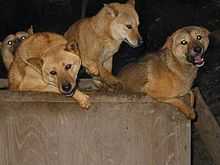Nureongi
 Nureongi / Hwanggu | |||||||||
| Country of origin | Korea | ||||||||
|---|---|---|---|---|---|---|---|---|---|
| |||||||||
| Dog (Canis lupus familiaris) | |||||||||
| Nureongi | |
| Hangul | 누렁이, 황구 |
|---|---|
| Hanja | 黃狗 |
| Revised Romanization | Nureongi |
| McCune–Reischauer | Nurŏngi |
The Nureongi (also spelled Noo-rung-yee)[1][2] is a yellowish landrace of dog from Korea. It is most often used as a livestock dog, raised for its meat and not commonly kept as a pet.
Description and population size
In a study about dog and cat meat consumption in South Korea, Anthony Podberscek of Cambridge University's Department of Veterinary Medicine notes that, while other kinds of dogs are also farmed and eaten, nureongi (yellow animal) is the dog most commonly used in this way. He describes them as "mid-sized, short haired, and yellow furred," notes that they "are not normally kept as pets," [3] and includes a photograph in which the specific dogs he refers to as “nureongi”, which he also calls "meat dogs," can be seen in the background, caged in an open-air meat market in South Korea. The dogs are quite uniform in appearance, medium-sized spitz-types with short yellow hair and melanistic masks.[4]
In a paper arguing in favor of dog meat consumption in South Korea, Dr. Ahn Yong Geun, (Ph.D. biology, Osaka City University, Japan, Professor in Food and Nutrition in Cheung Chong University) in South Korea, asserts the existence of a "unique" Korean "edible" dog "specifically bred and raised as food" which is not the same as the pet dogs Koreans keep and love and treat as family members. He cites evidence from Statistics Korea giving his reader some idea of how many such dogs there are. As of 1998, there were 2,246,357 dogs in Korea, but only 882,482 households with pet dogs, and as most Korean pet owners do not have more than one dog, the "unique" Korean livestock dog must have outnumbered all other kinds of dogs that lived in Korea in that year.[5][6]
Terminology
This dog has no formal name in the Korean language. Nureongi (누렁이) is an informal Korean word meaning "yellow one," and might best translate as "Brownie" or "Blackie" if those referred to a yellow animal, somewhat as the word "Yeller" has been used as a name for any yellow animal in English.[7] Hwanggu (황구; 黃狗) is a Sino-Korean compound meaning literally "yellow cur (dog)." Another common term is the Korean slang ddong-gae (똥개), meaning "dung dogs" or "shit dogs," which refers to the common dogs' habit of eating feces.[8][9] The dogs are generally considered by Koreans to be "mutts," "mongrels," or "curs" and are not normally allowed into the home.
The Korean culture and language distinguishes between these dogs and pet dogs. Chinese pet dogs such as Pekingese and beloved Korean hunting dogs such as the Jindo are spoken of using a more formal word of Chinese origin, gyeon (견; 犬 "hound, dog"), whereas street dogs, wolves, and meat dogs are labeled disparagingly with another word of Chinese origin, gu (구; 狗 "(feral) dog, mutt, cur"). Only the latter has been commonly used for foodstocks.
See also
References
- ↑ Morris, Desmond (2008). Dogs: The Ultimate Dictionary of Over 1,000 Dog Breeds. Trafalgar Square. ISBN 1-57076-410-7.
- ↑ "Dogs : the ultimate dictionary of over 1,000 dog breeds". WorldCat.
- ↑ Podberscek 2009 pp. 615–632
- ↑ Podberscek 2009 p. 623
- ↑ , first paragraph of 4th Section "Result", line 68.
- ↑ Ann, Yong-Geun. "Dog Meat Foods in Korea". Korean Medical Database. Retrieved 16 May 2013.
In the year of 1998, the heads of dog raised in Korea were 1,846,411, and the number of the households raising dogs is 819,112 which means that the heads of pet dog and edible dos were 819,112 and 1,027,299, respectively, because each house raised about one pet dog and one edible dog breeder raised hundreds of dog. In 1998, the number of exported dogs came to 28 heads, and that of imported dogs was 296 heads. But edible dog that was slaughtered or processed has not been reported to be exported or imported. It is known that at the Shenyang Xingshan Food Ltd in Shenyang, Chinese, 300,000 heads of dogs were raised, slaughtered and processed of dog meat per year, and 20% of them were exported. In Korea, the cook of dog meat is a special food culture with a long history. During the Chosun dynasty, dog meat had been eaten to be cooked diversely such as Gaejangkuk(a soup), Suyuk(a boiled meat), Sundae(a sausage), Kui(a roasted meat), Gaezim(a steamed meat), Nurumi(a meat roasted or fried, to which lot of spice paste are added), Gaesoju(an extract), Musulju(a wine), Musuldang(a sweet cane), Now, it is cooked as Bosintang(a soup), Suyuk(a boiled meat), Jeongol(boiled meat mixed with spices, vegetables and water on the pot), Duruchigi(boiled meat added spice vegatable and slightly roasted), Muchim(boiled meat added by spice and mixed), Gaesoju(an extract), with the number of recipes lessened, compared with those of the old times. The reason is due to the intervention and criticism from foreign countries. But foreigner´s blame for the dog meat is absurd and excessive action, because Korea raises exceptional dogs which are edible.
- ↑ Lee, Brian "Dogs May Be Designated as Livestock" JoongAng Daily, April 12, 2008
- ↑ Kim, Rakhyun E. (2008). "Dog Meat in Korea: A Socio-Legal Challenge". Animal Law 14 (2): 205.
- ↑ "똥개" [ddong-gae]. Naver Korean dictionary.
1. Poop eating mutts 2. Dogs eating and surviving on shit
- Podberscek, Anthony L. (2009). "Good to Pet and Eat: The Keeping and Consuming of Dogs and Cats in South Korea". Journal of Social Issues 65 (3): 615–632. doi:10.1111/j.1540-4560.2009.01616.x.
| ||||||||||||||||||||||||||||||||||